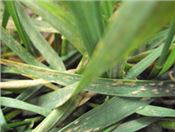Wet Conditions: Consider A Fungicide To Protect Flag Leaves And Prevent Head Scab
LAMAR, MO.
Jill Scheidt, agronomy specialist with University of Missouri Extension, scouted fields near Hwy. EE, east of I-49 and on the northeast side of Lamar for the April 19 crop scouting update.
WHEAT
Wheat was found to be in the heading and beginning flowering stages.
Scheidt observed powdery mildew moving up the plant, and present on some flag leaves.
Powdery mildew begins as light-green to yellow flecks on the leaf surface that develop into patches of cottony white mold growth that turn grayish in color. Temperature ranges of 59-72 degrees F and prolonged periods of cloudy weather favor powdery mildew development.
“High nitrogen levels, lush growth, and dense canopies also favor powdery mildew,” said Scheidt.
Scheidt recommends a fungicide treatment for head scab in wheat due to the warm weather and forecasted rains. Head scab develops in the flowering stages in humid, overcast weather conditions with temperature ranges from 77-86 degrees Fahrenheit and when wheat is subject to prolonged wetness.
“Head scab can result in blank kernels and possible mycotoxin development, which is toxic to humans and livestock at varying levels. The best time to apply a head scab fungicide for the most effective results is when 50 percent of flowering is complete,” said Scheidt.
CORN
Corn was found to be in the emerging to the third leaf stages.
“The lower leaves looked tattered from the recent rains. No black cutworm or other insect damage was seen. Black cutworms should be scouted for as they are more common in wet weather. Look for plants that are cut off at or just below the soil level when scouting for black cutworm damage,” said Scheidt. ∆

Powdery mildew
Photo credit: MU Extension